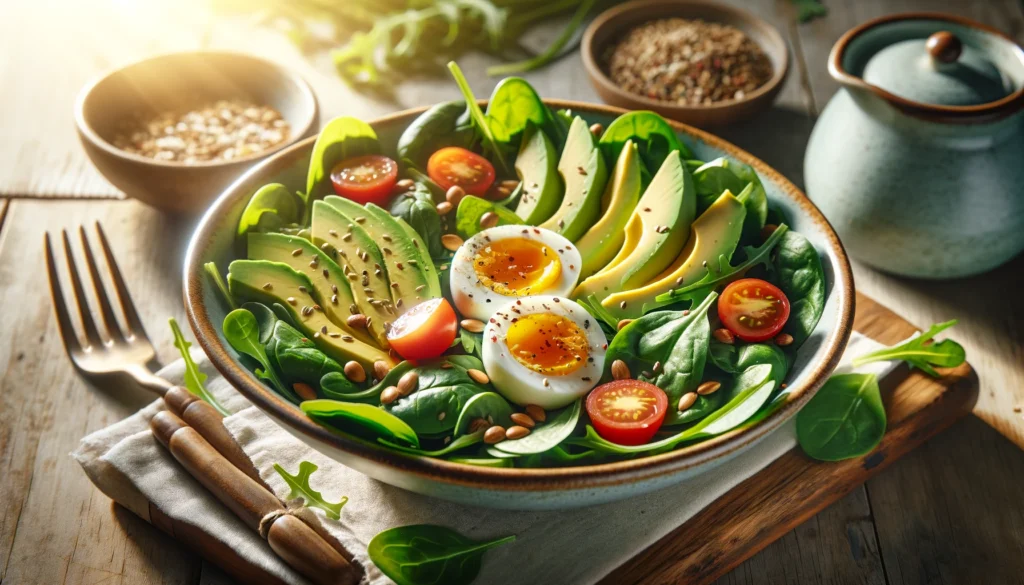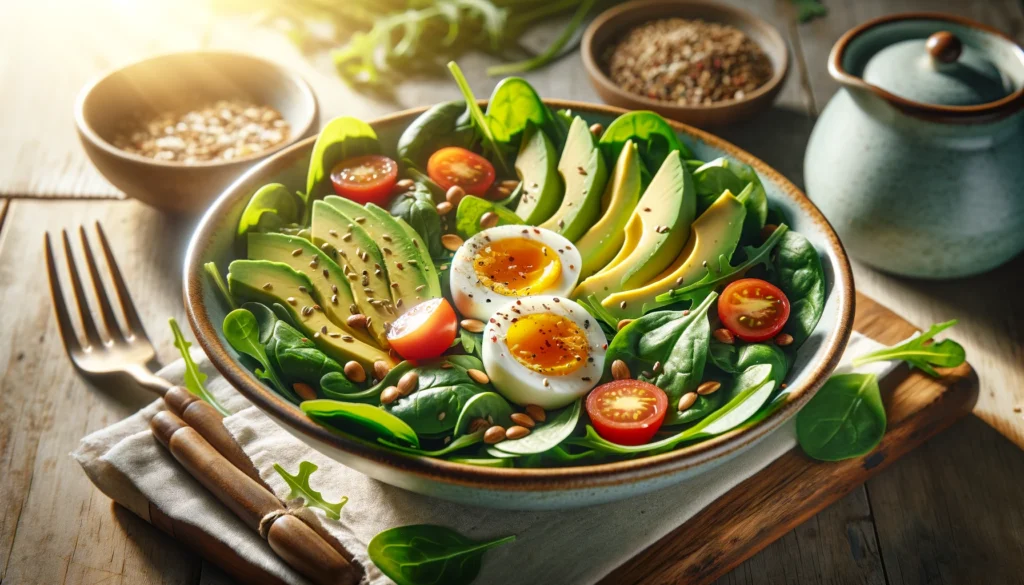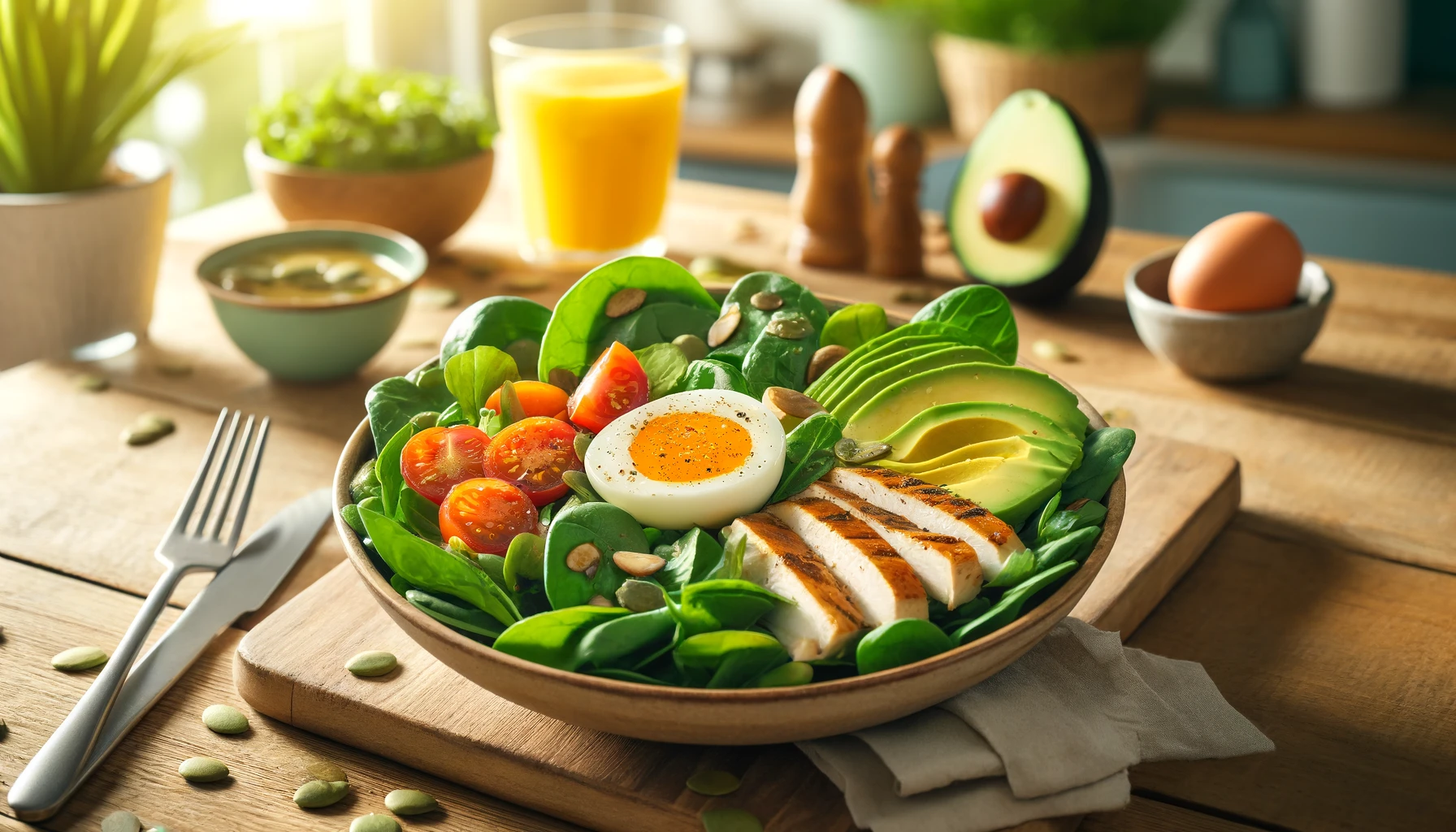Breakfast salads offer a refreshing twist to traditional morning meals, combining the freshness of leafy greens with a variety of flavorful ingredients. The idea of a breakfast salad might seem unconventional, but it provides a nutritious and energizing start to the day, setting a healthy tone for the hours ahead.
The appeal of a breakfast salad lies in its ability to provide a well-rounded meal that includes vegetables, fruits, proteins, and healthy fats. This combination not only satisfies hunger but also delivers essential nutrients that can boost energy levels and promote overall well-being.
By incorporating ingredients like leafy greens, eggs, avocado, nuts, seeds, and fresh fruits, breakfast salads offer a diverse range of flavors and textures that can be tailored to individual tastes. Whether you prefer a light and refreshing salad or a more substantial meal, the versatility of breakfast salads makes them a delicious and satisfying choice for any morning.

What is a Breakfast Salad
A breakfast salad is a refreshing and nutritious dish typically enjoyed in the morning. It’s a departure from traditional breakfast foods like eggs and toast, offering a lighter, vegetable-forward option to start your day. The salad can vary widely in its components and flavors but usually includes a mix of vegetables, fruits, grains, proteins, and dressings. For those interested in incorporating more greens and proteins into their breakfast, consider exploring articles like greens and protein for added benefits.
Common components of a breakfast salad include:
Common components of a breakfast salad include greens such as spinach, kale, arugula, or mixed salad greens, providing a base of vitamins and minerals. Protein sources might include eggs, bacon, smoked salmon, or tofu, all of which help keep you full and satisfied. For alternative protein-rich breakfast options, check out the Turkey Egg Breakfast Casserole recipe. Grains like quinoa, farro, or whole grain bread can add fiber and complex carbohydrates for energy.
Vegetables such as tomatoes, cucumbers, bell peppers, avocado, and onions are popular choices, adding color, flavor, and nutrients. When discussing avocados, linking to the Healthy Avocado Toast Recipe can provide readers with another delightful breakfast option. Fruits like berries, apples, oranges, or dried fruits add a sweet and juicy element, while nuts and seeds such as almonds, walnuts, or pumpkin seeds introduce crunch and healthy fats.
The dressing, a critical component, could be a light vinaigrette, yogurt-based dressing, or citrus dressing, tying the flavors together. For more ideas on yogurt-based options, the Greek Yogurt Parfait recipe could offer useful insights.
Variations of breakfast salads can be found across different cuisines and personal preferences. In Mediterranean cuisine, a breakfast salad might include tomatoes, cucumbers, olives, feta cheese, and a lemon-herb dressing. In Asian cuisine, it might feature mixed greens, avocado, edamame, sesame seeds, and a ginger-soy dressing. Personal preferences can also play a role, with some people opting for a more savory salad with bacon and eggs, while others prefer a sweeter version with fruits and nuts.
Overall, a breakfast salad is a versatile and customizable dish that can be tailored to suit different tastes and dietary needs, providing a healthy and satisfying start to the day.
Mixed Greens
Description: Mixed greens typically include a variety of leafy vegetables like spinach, kale, arugula, and lettuce. They provide a base of freshness and crunch to the salad.
Nutritional Benefits: Healthy Breakfast Salad.
- Vitamins and Minerals: Rich in vitamins A, C, and K, which are important for immune function, skin health, and blood clotting.
- Antioxidants: Contains antioxidants like beta-carotene and lutein, which help protect cells from damage.
- Fiber: High in fiber, aiding digestion and promoting a feeling of fullness.
- Low Calorie: Low in calories but high in nutrients, making them a great choice for weight management.
Boiled Eggs
Description: Boiled eggs add a protein boost to the salad and a creamy texture to the dressing.
Nutritional Benefits:
- Protein: High-quality protein source, essential for muscle repair and growth.
- Choline: Contains choline, important for brain health and metabolism.
- Vitamins: Rich in vitamins B2, B12, and D, important for energy production and bone health.
- Satiety: Helps increase feelings of fullness, reducing overall calorie intake.
Avocado
Description: Avocado adds creaminess and a healthy dose of monounsaturated fats to the salad.
Nutritional Benefits:
- Healthy Fats: Rich in monounsaturated fats, which are heart-healthy and may help lower cholesterol levels.
- Fiber: High in fiber, aiding in digestion and promoting satiety.
- Vitamins and Minerals: Contains vitamins E, K, C, and B-6, as well as riboflavin, niacin, folate, magnesium, and potassium.
- Antioxidants: Contains antioxidants like lutein and zeaxanthin, which are important for eye health.
Nuts
Description: Nuts add crunch, flavor, and a dose of healthy fats to the salad.
Nutritional Benefits:
- Healthy Fats: Rich in monounsaturated and polyunsaturated fats, which are beneficial for heart health.
- Protein: Good source of plant-based protein, important for muscle repair and growth.
- Fiber: High in fiber, aiding in digestion and promoting satiety.
- Vitamins and Minerals: Contains vitamins E, B2, and folate, as well as minerals like magnesium, phosphorus, and selenium.
Step-by-Step Recipe: Mixed Greens Salad with Boiled Eggs, Avocado, and Nuts

Preparation of Mixed Greens:
- Selection Tips: Choose a variety of mixed greens, such as spinach, arugula, and kale, for a flavorful and nutritious base.
- Washing: Rinse the mixed greens thoroughly under cold water to remove any dirt or debris.
- Drying: Pat the greens dry with a clean kitchen towel or use a salad spinner to remove excess water.
- Tearing or Cutting: Tear larger leaves into bite-sized pieces or leave them whole, depending on your preference.
Boiling Eggs:
- Selecting Eggs: Choose fresh eggs for boiling.
- Boiling: Place eggs in a saucepan and cover with cold water. Bring to a boil over medium-high heat.
- Cooking Time: For soft-boiled eggs, cook for 6-7 minutes. For medium-boiled eggs, cook for 9-10 minutes. For hard-boiled eggs, cook for 12-14 minutes.
- Cooling: Remove eggs from heat and place them in a bowl of ice water to stop the cooking process. Peel when cool enough to handle.
Choosing and Slicing Avocados:
- Ripeness: Choose avocados that yield slightly to gentle pressure but are not mushy.
- Cutting: To slice an avocado, cut it in half lengthwise around the seed. Twist the halves to separate them. Remove the seed and use a spoon to scoop out the flesh.
- Slicing: Place the avocado halves cut-side down on a cutting board and slice them lengthwise or crosswise, depending on your preference.
Types of Nuts and Preparation:
- Walnuts: Toast walnuts in a dry skillet over medium heat for 5-7 minutes, stirring occasionally, until fragrant. Chop them before adding them to the salad.
- Almonds: Toast almonds in the oven at 350°F (175°C) for 8-10 minutes, or until golden brown. Slice or chop them before adding to the salad.
- Pecans: Toast pecans in a dry skillet over medium heat for 4-5 minutes, stirring frequently, until fragrant. Chop them before adding them to the salad.
- Cashews: Cashews can be used raw or toasted for added flavor. If toasting, heat them in a dry skillet over medium heat for 3-5 minutes, stirring frequently.
Assembling the Salad:
- Mixing Greens: In a large bowl, combine the mixed greens.
- Adding Eggs and Avocado: Peel and slice the boiled eggs. Add them to the greens along with the sliced avocado.
- Sprinkling Nuts: Sprinkle the toasted nuts over the salad.
- Dressing: Drizzle your favorite dressing over the salad, or serve it on the side for individual preference.
- Optional Additions: You can also add other toppings like cherry tomatoes, cucumbers, or radishes for extra flavor and texture.
Customization Ideas
Adding Proteins:
- Grilled chicken, shrimp, or tofu can add a hearty protein boost.
- Beans such as chickpeas, black beans, or edamame are great vegetarian options.
- Quinoa or farro can be cooked and added for a protein-rich grain component.
Dressing Choices:
- Classic vinaigrette with olive oil, vinegar, and mustard.
- Creamy dressings made with yogurt or tahini for a vegan option.
- Citrus-based dressings for a refreshing twist.
Alternative Greens:
- Kale, massaged to soften its texture, adds a nutrient-dense base.
- Arugula or watercress adds a peppery bite.
- Radicchio or endive for a bitter contrast.
- Mixed baby greens for a simple, mild option.
Vegan Modifications:
- Replace animal proteins with grilled tofu, tempeh, or marinated portobello mushrooms.
- Use dairy-free cheese alternatives or sprinkle with nutritional yeast for a cheesy flavor.
- Opt for vegan dressings or make your own with plant-based ingredients like avocado, tahini, or soy yogurt.
Other Dietary Restrictions:
- For gluten-free diets, ensure dressings and toppings are gluten-free or make your own.
- Nut allergies can be accommodated by omitting nuts or using seeds like sunflower or pumpkin.
- For low-carb diets, limit high-carb toppings like croutons and opt for extra protein and vegetables.
- Those with lactose intolerance can choose lactose-free cheese or skip it altogether.
Customizing your salad with these ideas can make it a satisfying and nutritious meal that suits your dietary preferences and restrictions.
Serving and Presentation Tips
For an aesthetically appealing salad presentation, consider the following tips:
- Use a variety of colors: Include different colored vegetables, fruits, and toppings to create a visually appealing contrast.
- Layer ingredients: Arrange the ingredients in layers or sections rather than mixing everything together. This adds texture and makes the salad visually interesting.
- Garnish creatively: Use fresh herbs, edible flowers, or toasted nuts/seeds as garnishes to enhance the look of the salad.
- Use an interesting serving dish: Serve the salad in a unique or stylish bowl or platter to elevate its presentation.
- Dress lightly: Toss the salad with dressing just before serving to prevent wilting and maintain the freshness of the ingredients.
- Serve chilled: If possible, chill the serving dish before adding the salad to keep it fresh and crisp.
For pairing suggestions, consider the following:
- Beverages: Pair the salad with a light and refreshing beverage such as iced tea, lemonade, or a crisp white wine. For a more savory salad, consider a light beer or a chilled soup.
- Side dishes: Serve the salad as a side dish with grilled chicken, fish, or a sandwich. Alternatively, pair it with a side of crusty bread or a light soup for a more substantial meal.
FAQs
Q: What are the best greens to use for breakfast salads?
A Guide to Healthy Breakfast Salad Greens: The best greens for breakfast salads are those that offer a balance of flavor and texture. Baby spinach, arugula, and kale are popular choices. They provide a fresh, vibrant base and are packed with nutrients. You can also mix in some softer greens like butter lettuce or mache for a more delicate texture. Experiment with different combinations to find your favorite.
Q: What are some alternative ways to prepare eggs for breakfast?
A: There are many delicious ways to prepare eggs beyond the traditional scrambled, fried, or boiled. Consider poaching eggs and serving them over toast or avocado. You can also bake eggs in muffin tins with veggies and cheese for easy grab-and-go egg cups. Another option is to make a frittata, which is similar to an omelette but easier to prepare since it’s baked in the oven. Lastly, eggs can be cooked in a variety of ways in breakfast casseroles or quiches for a hearty meal. Explore these egg-citing options for a Healthy Breakfast Salad!
Q: Can I make breakfast salads ahead of time?
A: Yes, you can prepare breakfast salads ahead of time, but there are some considerations. To keep the greens fresh, store them separately from any dressing or wet ingredients. You can also prep some ingredients in advance, like chopping vegetables or cooking grains, and assemble the salad just before serving. Alternatively, consider making a batch of salad jars, layering the ingredients with the dressing on the bottom and the greens on top, which helps keep everything fresh until you’re ready to eat.
Q: How can I add more protein to my breakfast salad?
A: To add more protein to your breakfast salad, consider incorporating ingredients like hard-boiled eggs, cooked quinoa, chickpeas, tofu, or nuts and seeds. These additions not only boost the protein content but also add texture and flavor to your salad.
Q: Are breakfast salads suitable for meal prep?
A: Yes, breakfast salads can be great for meal prep. Prepare all the ingredients in advance and store them separately. When you’re ready to eat, simply assemble the salad, add your dressing, and enjoy!
External Links :
Here are three external links that provide useful information and perspectives on “Healthy Breakfast Salad: Morning with Greens and Protein”:
- PubMed – This resource offers a wealth of scientific articles and research papers on various health topics, including studies on the nutritional benefits of greens and proteins in breakfast salads. You can explore extensive biomedical literature to find detailed research on how such meals can impact health and well-being. Visit PubMed
- edX – While primarily an educational platform, edX offers courses related to nutrition and health that may include content on preparing healthy breakfasts incorporating greens and proteins. These courses could provide deeper insights into the nutritional science behind healthy eating practices. Explore edX
- PBS KIDS for Parents – Although not directly related to ‘Healthy Breakfast Salad,’ PBS KIDS for Parents offers general advice on healthy eating for children. It can be a good resource for parents looking to integrate nutritious options like breakfast salads into their children’s diets. Visit PBS KIDS for Parents

